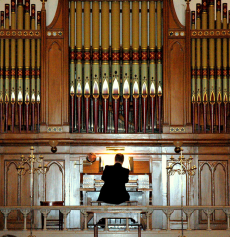
Instrumentally, there is a horn section, which again, due to the rich timbre of the sound, adds to the optimistic ambience of the piece, and serves to place the music in its historical context; as we no longer typically have jazz horn sections within popular music, the use of such can thus be associated with certain areas of music, such as that of the World War Period when that type of arrangement was the norm. The Brass to me works to suggest the military setting as well; the lyrics being about soldiers leaving and hopefully being reunited with their lovers and family members at a later date, and the steady brass with the relaxed swing beat reminds the audience of the organisation and regimen of the army, of the military music corp perhaps, but the feeling remains positive due to the key. The slurred notes of the verses maintain the sense of calm, and prevent there from being any sense of urgency or fear. There is a string section in the backing of the piece, but it remains light and ‘bright’ in its sound throughout, giving the song the perfect ‘finish,’ by subtly uplifting the entire piece with the beautiful scaleic ascension of their melodic part. It is no wonder, with this simple yet, perfectly orchestrated piece that it is proving to be a powerful tool for the current generation that is afflicted with Dementia.
Evidence of Musical Impact:
Religious songs such as Hymns also seem to have an effect upon those with neurodegenerative conditions. It could be argued that this is because of the memories of the Church itself, or the deep-rooted religious faith, or even the memories of community and family associated with the music. However, it could be the unique stylistic elements of the music; the particular imagery of the lyrics, and the instrumental choice, such as the incorporation of the Organ, which is not typically found in most music. Perhaps it is these things that make the music so distinct, and so successful at illuminating neural pathways. Claire Garabedian, a cellist who is investigating the impact of music upon patients with Dementia, said, ‘Even when someone can no longer talk… music becomes an avenue for communication.’ Her statement reflects the crucial intertwining link between language, music and communication, that has long been speculated by everyone from Rousseau to Darwin. It certainly suggests that music has an innate ability to help us communicate when other cognitive functions are severely diminished or lost entirely.
An Organist, Paul Robertson echoes this sentiment, recalling an incident wherein he was playing at a Church, and there was a woman with ‘advanced Dementia’ in attendance; ‘She was very far gone, no language, no recognition. Someone started singing a hymn and this woman sat down at the piano, found the right key and accompanied the singer in perfect order.' Evidently a neural connection had lit up due to the Organ being played in conjunction with the vocals, triggering a very specific memory, that was in fact a functional memory. That this woman was able to remember how to play a specific piece of music despite the level of neurodegeneration, is highly demonstrative of the potential of music to reshape the brain, to aid the restoration of functions, and ultimately improve life quality.
image:http://theoldchurch.org/organ/

0 Comment:
Be the first one to comment on this article.